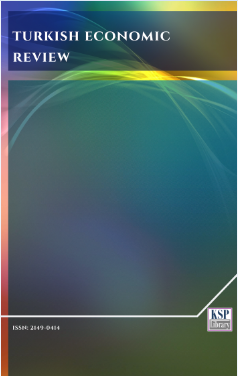The analysis of bubbles and crashes on financial markets for emerging economies: Evidenced From BRICS
Abstract
Abstract. The study was conducted to analyze the bubbles, and crashes on the financial market in emerging economies; (BRICS) stock prices were employed to detect the existence of the bursting bubble. The Right-tailed Augment Dickey-Fuller Unit Root Test used to complete the study of analyzing bubbles and crashes. The study consists of four primary tests; ADF, RADF, SADF, and GSADF Moreover, the study used the first three criteria. The survey covered the period from 2000 to 2016, to absorb the nuclear currently financial crisis in the BRICS and analyze its impacts. Also, this period coincides with both economic reforms in some countries like China and early indications of an impending US crisis. The findings in all countries rejected the null hypothesis of no bursting bubbles in the stock market in favor of the alternative theory. The findings suggest that such an explosive behavior may be attributable to differences in stock prices of traded goods. The result has economic policy importance and implications on the economy.
Keywords. BRICS, Emerging economies, Financial bubble and crashes, Right-tailed ADF, Stock price.
JEL. F60, G70, O15.Keywords
References
Abreu, D., & Brunnermeier, M.K. (2003). Bubbles and crashes. Econometrica, 71(1), 173-204. doi. 10.1111/1468-0262.00393
Ausloos, M., & Ivanova, K. (May 01, 2002). Mechanistic approach to generalized technical analysis of share prices and stock market indices. The European Physical Journal B - Condensed Matter and Complex Systems, 27(2), 177-187. doi. 10.1140/epjb/e20020144
Brunnermeier, M.K. (2001). Asset Pricing Under Asymmetric Information: Bubbles, Crashes, Technical Analysis, and Herding. Oxford University Press.
Elike, U., & Anoruo, E. (2017). Testing for explosive bubbles in the South African-US exchange rate using the sequential ADF procedures. Banks and Bank Systems, 12(1), 105-112. doi. 10.21511/bbs.12(1-1).2017.02
Evans, G.W. (1991). Pitfalls in testing for explosive bubbles in asset prices. The American Economic Review, 81(4), 922-930.
Friedman, M., Savage, L.J., & Becker, G.S. (2007). Milton Friedman on Economics: Selected Papers. Chicago: University of Chicago Press.
Garber, P.M. (2000). Famous First Bubbles: The Fundamentals of Early Manias. MIT Press, Cambridge, MA.
IMF, (2013). World Economic Outlook. [Retrieved from].
Janszen, E. (2008). The next bubble: Priming the markets for tomorrow's big crash. Harper’s, 39-45.
Johansen, A., & Sornette, D. (2001). Finite-time singularity in the dynamics of the world population, economic and financial indices. Physica A, 294(3-4), 465-502. doi. 10.1016/S0378-4371(01)00105-4
Johansen, A., & Sornette, D. (2010). Shocks, crashes and bubbles in financial markets. Brussels Economic Review, 53(2), 201-253.
Kaizoji, T. (2005). Statistical properties of absolute log-returns and a stochastic model of stock markets with heterogeneous agents. Nonlinear Dynamics and Heterogeneous Interacting Agents, 550, 237-248. doi. 10.1007/3-540-27296-8_16
Kaizoji, T. (2006). A precursor of market crashes: Empirical laws of Japan's Internet bubble. The European Physical Journal B, 50(1), 123-127. doi. 10.1140/epjb/e2006-00142-9
Kyle, A.S., & Wang, F.A. (1997). Speculation duopoly with agreement to disagree: Can overconfidence survive the market test?, Journal of Finance, 52(5), 2073-2090. doi. 10.1111/j.1540-6261.1997.tb02751.x
Lux, T. (1995). Time variation of second moments from a noise trader/infection model. Bamberg: Ott-Friedrich-Univ., Fak. Sozial- und Wirtschaftswiss.
Phillips, P.C.B., Shi, S., & Yu, J. (2015). Testing for multiple bubbles: Limit theory of real-time detectors. International Economic Review, 56(4), 1079-1134. doi. 10.1111/iere.12131
Phillips, P.C.B., Wu, Y., & Yu, J. (2011a). Explosive behavior in the 1990s nasdaq: When did exuberance escalate asset values?, International Economics Review, 52(1), 201-226. doi. 10.1111/j.1468-2354.2010.00625.x
Phillips, P.C.B., & Yu, J. (2011). Dating the timeline of financial bubbles during the subprime crisis. Quantitative Economics, 2(3), 455-491. doi. 10.3982/QE82
Rayan, K. (2008). Financial Leverage and Firm Value. Johannesburg: GIBS.
Scheinkman, J.A., & Xiong, W. (2003). Overconfidence and speculative bubbles. Journal of Political Economy, 111(6), 1183-1219. doi. 10.1086/378531
Shiller, R.J. (1999). Measuring bubble expectations and investor confidence. NBER Working Paper, No.7008. doi. 10.3386/w7008
Shiller, R.J. (2003). From efficient market theory to behavioral finance. Journal of Economic Perspectives, 17(1), 80-104.
Sornette, D. (2003). Why Stock Markets Crash: Critical Events in Complex Financial Systems. Princeton, N.J: Princeton University Press.
Sornette, D. (2003). Critical market crashes. Physics Reports, 378(1), 1-98. doi. 10.1016/S0370-1573(02)00634-8
Zikmund, W.G. (1997). Exploring Marketing Research. Fort Worth, TX: Dryden Press.
DOI: http://dx.doi.org/10.1453/ter.v5i1.1569
Refbacks
- There are currently no refbacks.
.......................................................................................................................................................................................................................................................................................................................................
Turkish Economic Review - Turk. Econ. Rev. - TER - www.kspjournals.org
ISSN: 2149-0414
Editor: [email protected] Secretarial: [email protected] Istanbul - Turkey.
Copyright © KSP Library




